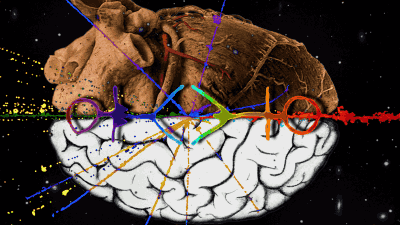It turned out that the activity of intestinal bacteria affects the neural circuit connecting the intestine and the brain and controls the intestinal movement

The human intestine has about 100 million
Microbiota modulate sympathetic neurons via a gut–brain circuit | Nature
https://www.nature.com/articles/s41586-020-2474-7
Brain-Gut Circuit Lets Microbiota Directly Affect the Sympathetic Nervous System | Technology Networks
https://www.technologynetworks.com/tn/news/brain-gut-circuit-lets-microbiota-directly-affect-our-sympathetic-nervous-system-338082

The United States of
A germ-free mouse is a mouse that has been raised in an isolated environment from the time of birth and is free of microorganisms including viruses and parasites on the body surface and body. Sterile mice are fed only thoroughly sterilized food and water to avoid contact with microorganisms while growing, and they also do not have the intestinal bacteria that normal mice have.
The research team found that germ-free mice have more active neurons that control intestinal motility than normal mice, and that a gene called c-Fos , a marker of neuronal activity, is expressed at high levels. By activating the activity of neurons that control intestinal motility, it was also found that germ-free mice were slower in passing food through the digestive tract than in normal mice. In fact, when the research team used a drug to calm the neurons of the intestine of germ-free mice, it seems that food passed through the digestive tract faster.

Regarding the question 'how do intestinal neurons sense the presence or absence of intestinal bacteria?', the research team says that the levels of
However, further experiments revealed that 'the intestinal neurons activated by the amount of short-chain fatty acids did not reach the exposed intestinal surface.' In other words, the activated neurons were unable to directly sense how much short-chain fatty acids in the intestine were.
So the research team decided to follow the neuron circuit 'in reverse'. Then, when the intestinal neurons in germ-free mice were activated, brain neurons that were also activated were found. When this neuron in the mouse brain was specifically activated, the activity of the neuron that controls the intestinal movement was activated, and the intestinal movement was changed.
In addition, the team traced the neurons backwards, discovering that sensory neurons in the gut, which signal neurons in the brain, spread to areas of the gut that can sense short-chain fatty acid levels. Sensory neurons sense the amount of short-chain fatty acids in the intestine, which sends signals to brain neurons, which then send signals to neurons that control intestinal motility, controlling mouse intestinal motility. The circuit that has been revealed has been revealed.

'We found that we could follow the entire loop of neurons and control what happens to neurons outside the gut,' says Mucida. Since some of the neurons contained in the circuit are associated with diseases such as irritable bowel syndrome , circuit abnormalities may be associated with intestinal disorders and neurological disorders.
Related Posts:







